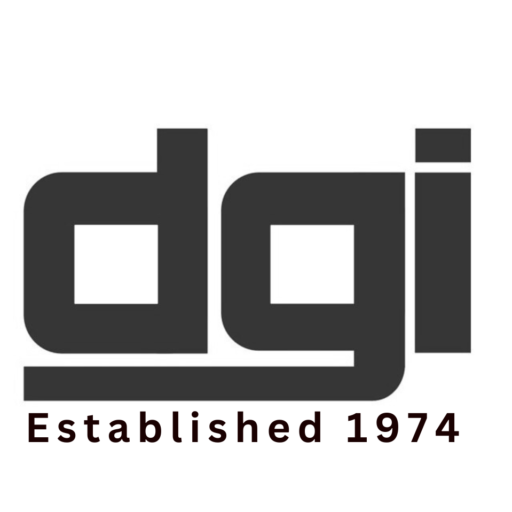DGI – QUALITY ASSURANCE & MANUFACTURE
DGI are a founding member of the Glulam Timber Association of Australia (GLTAA), DGI have been pre-eminent in the field since starting in 1974. Our Engineering department and Technical consultants have been used by many areas of Industry for technical advice on Glulam usage as well as timber behaviour, installation and design in many varied environments.
Although generally seen as “merely sticking bits of wood together”, DGI Glulam is much, much more, as can be seen by the following processes.
Material Selection
Moisture Content (MC)
Because the correct seasoning of timber is so critical to ultimate glueline performance as well as long term stability (the ability of the overall slab to remain flat and relatively ‘warp free’), MC checks are carried out at various stages of the process. Different species will determine the initial specified MC: for successful gluing, some very dense hardwoods will require lower MC than normal, and many tests are done in our laboratory to determine the best MC/machining/gluing regime so as to ensure ultimate performance.
The first test is done when the timber initially enters our yard from the sawmiller. To ensure that MC then doesn’t vary over time with storage and variances in atmospheric humidity, only enough material for scheduled production is ordered. MC is then rechecked at various stages of the production process.
MC testing is done by pin electronic moisture meters, both on surface and internally. The aim ultimately, is to ensure that the total product is at Equilibrium Moisture Content (EMC) when manufacture is complete. This means that the external ambient humidity and the internal timber MC are balanced and in harmony. Generally, for most of urban Australia, this is about 12% MC.
Timber Grading
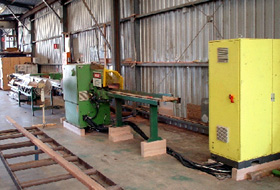 The rough timber laminates are checked for defects. Those that are obvious and go through the piece are docked out. Where possible, a good face is maintained by turning one-sided defects to the bottom of the eventual slab. Timber is also checked for conformance to the specifications required to obtain the eventual required finished laminate size.
The rough timber laminates are checked for defects. Those that are obvious and go through the piece are docked out. Where possible, a good face is maintained by turning one-sided defects to the bottom of the eventual slab. Timber is also checked for conformance to the specifications required to obtain the eventual required finished laminate size.
There is a considerable amount of necessary wastage involved in manufacturing Glulam, which determines the ultimate price. Generally, starting with a 50x25mm rough laminate (1250m2) the finished laminate size is 35×19 (665m2): this is a 47% loss of material before any docking/defect wastage is accrued.
Fingerjointing
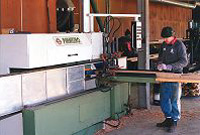 Where it is difficult to obtain long length laminates adequate for the range of lengths required, fingerjointing of laminates is required. This produces a strong joint that holds the pieces together for the machining and gluing processes. It is also utilised to join pieces together after any observed defects are docked out.
Where it is difficult to obtain long length laminates adequate for the range of lengths required, fingerjointing of laminates is required. This produces a strong joint that holds the pieces together for the machining and gluing processes. It is also utilised to join pieces together after any observed defects are docked out.
DGI has two fingerjointing lines: Structural and Decorative. These produce different design fingerjoints: structural for strength, with long, strong fingers, with a tip gap designed to avoid ‘bottoming out’; decorative for aesthetics, with shorter fingers and no gap at the tip.
Machining
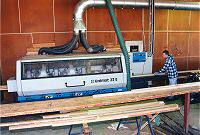 The next process takes the laminates in the rough through a moulding machine.
The next process takes the laminates in the rough through a moulding machine.
The moulder cleans all four sides of the laminate to exact tolerances. Speed of machining is critical, as too fast will create a slightly uneven surface which will show too large a glue line later, and too slow a speed will burn the wood.
DGI’s state of the art Weinig moulder has six cutting heads, which in addition to machining all four sides of each laminae a bank of saws can be placed on one of the horizontal heads. These saws can be set so as to rip wide timber to one or more pieces so as to produce the laminae sizes required for the specific species.
Care is taken when ripping to ensure that MC is continuous throughout the slab, as high internal MC (often called ‘locked in Core moisture’) can cause ultimate checking or even laminate collapse.
Sorting / Pre-conditioning
 Laminates are sorted to corresponding lengths and colours and pre-heated for 12 hours to obtain even internal heat. This aids in the glue curing process.
Laminates are sorted to corresponding lengths and colours and pre-heated for 12 hours to obtain even internal heat. This aids in the glue curing process.
Because many Australian hardwoods have odd chemistry with an abundance of resins that may return to the surface not long after machining, it is often critical to apply glue at a particular time after machining whilst the surface is fresh and clean.
Glue Spreader
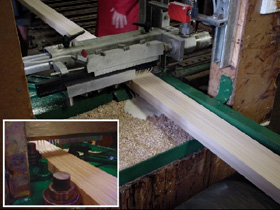 From the pre-conditioning room, laminates are fed on a conveyor belt through one of the glue spreaders. Two are used, dependent on the type of glue required for the particular product being processed.
From the pre-conditioning room, laminates are fed on a conveyor belt through one of the glue spreaders. Two are used, dependent on the type of glue required for the particular product being processed.
Non-Structural DGI Glulam is glued with moisture curing Polyurethane resin (PUR) which has a high level of water and solvent resistance. Because PUR’s cure by moisture from the atmosphere and within the timber itself, the glue has to remain completely protected from the atmosphere until application occurs. DGI have installed a German OEST PUR Applicator and at the time of writing we are the only company in Australia to embrace this modern technology.
Other normally efficient wood working glues, such as PVA, Epoxy, PRF and Iso-cyanate, tend to be unsuitable because of deficiencies in moisture resistance, solvent resistance, creep characteristics or unsuitable colour. Again, because of the large number of glue lines, any poor performance in the glue could effect the finished product.
Structural Glulam beam is glued with Phenol Resorcinol Formaldehyde (PRF). This glue is specified in AS/NZ 1328. It is fully waterproof and has proven long-term performance. PRF’s are a two part glue and mix is critical. Accurate glue mixing machines and scales are used to ensure correct catalisation. The glue is then fed into hoppers mounted at the top of the glue spreader, which spreads the glue at a predetermined rate and consistency.
Planing / Sanding
Boards are first planed top and bottom through a planer, then through a series of wide belt sanders which take the surface to 100-150 grit.
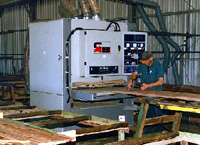
Testing
Species Suitability – prior to selection of a species for gluing, various trials are undertaken to determine performance, adhesion and longevity. This process usually takes 8-10 months, and ensures that timbers that are difficult to glue, have poor stability characteristics, or display drying or defect problems, are not released into the marketplace where future problems may ultimately show themselves.
Proof Testing – Various tests are done as part of the DGI Quality Assurance program to ensure the product meets relevant Australian standards, and some of the more rigorous criteria established by the DGI laboratory team. These tests are done on pieces cut from actual production slabs, and records are kept of results and processing batches.
i) Block shear test – this measures the strength of the fingerjoints by putting stress on the joint until breakage occurs.
ii) Cleavage test – this tests the adhesion of the glue, measuring the amount of wood failure when the glueline is broken. DGI expect a high degree of wood failure (rather than glueline failure), and the degree of wood failure expected will be determined by the criteria established for each species.
iii) Boil/Water resistance test – 72 hour boiling water immersion test to determine suitability to high humidity and long term water exposure.
iv) Moisture Content test – finished pieces are again checked for accurate moisture content by “Oven Dry” method.
v) Solvent resistance test – after allowing full glueline cure, various solvents and chemicals are used to saturate the surface to determine overall resistance.
vi) Glue Quality checks – Glue batches are tested and recorded for ‘Use by dates’ and viability.
Warranty
 DGI GLULAM is warranted free from manufacturing defects and the performance of the product is guaranteed for 7 years providing the conditions relating to handling and storage are adhered to, and that fabrication and installation has been performed to DGI’s recommendations.
DGI GLULAM is warranted free from manufacturing defects and the performance of the product is guaranteed for 7 years providing the conditions relating to handling and storage are adhered to, and that fabrication and installation has been performed to DGI’s recommendations.
We at DGI believe that your Glulam product should give years of service; our manufacturing and quality control processes strive to produce items of durability and practicality. All we ask in return is that the installation, sealing and care instructions are adhered to, and that the product is not used in areas of extreme climatic conditions.
Our warranty does not cover external usage unless the product has been specifically manufactured for that purpose eg. Treated Pine structural beams. Generally our products are specifically designed for internal use.
